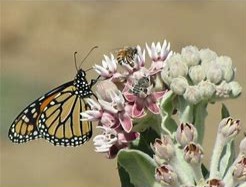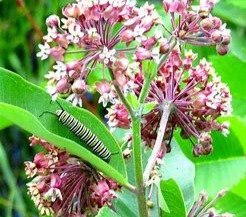Milkweed's Monarch Habitat
- Sarah Dafoe

- May 17, 2022
- 6 min read

Showy Milkweed (Asclepias speciosa) is a milky-sapped perennial plant in the dogbane family (Apocynaceae). This genus of plants is named after Asclepius, the god of medicine and healing in ancient Greek mythology. Milkweeds have a long history of being worked with for medicinal purposes because of the cardiac glycosides found in their tissue. Native to the Western half of North America, growing along streams, dry slopes, open woodland areas and roadsides, it was introduced to Europe by French and English explorers in the 1500s and 1600s.
In 1892, Charles Millspaugh recorded the early medical history of milkweed, also known as pleurisy root. He stated that it is a proven remedy for certain forms of dry coryza, indigestion, colic, diarrhea, dry coughs, pleurisy, rheumatic pains, and some skin affections. The milky white sap is sometimes applied topically to remove warts. Caution: Some people have allergic reaction to the milky sap and should avoid contact with the eyes by washing hands thoroughly after touching.
Native people, early settlers, and modern foragers alike have eaten milkweed as a cooked vegetable. Nearly every part is edible, but each must be harvested at just the right time. Young, tender shoots in early spring; unopened flower buds in midsummer; firm, green seedpods in late summer — all can be eaten if they are boiled in multiple changes of water. Cook the unopened flower buds very well in sugar water until it thickens into a syrup, then strain out the cooked flowers and drizzle the milkweed flower syrup lightly over a dish of vanilla ice cream.
However, if the plants are eaten raw or are too old or picked at the wrong time, they

may cause nausea or vomiting as the cardiac glycosides found in Milkweed are poisonous to animals and humans. This is a plant which can be appreciated for its variety of chemical compounds, but not necessarily to be dabbled with by those who are not professionals, in working with its medicinal properties. Instead we can marvel at its other abilities to support the variety of pollinators which it attracts. Monarch butterflies in particular have used the poisonous compounds from Milkweed as their chemical defense against predators who know to avoid them so they do not suffer from the poisonous affects.

Probably the best-known fact about milkweed is that it’s a host plant for butterflies like the monarch. In reality, though the plants are food for several different species of butterflies (not to mention a source of nectar for moths, bees and hummingbirds). Butterflies don’t only need nectar, but they also need milkweed to lay their eggs on and the ONLY food the monarch caterpillars can eat are the leaves of milkweed plants. With shifting land management practices and pesticide use, we have lost much milkweed from the landscape. This has led to a 90% decline in the number of eastern monarchs in a just single decade.
Growing any of the milkweed species in your garden will attract a wonderful array of pollinators and you will be helping to sustain the habitat and species of the monarch butterfly.
Fun Facts About Milkweed
Ironically (given its reputation as a host plant for pollinators), milkweed can also be applied as a pesticide! Its seeds contain cardenolides, a compound that kills nematodes and armyworms. These are destructive pests for crops such as potatoes, soybeans, alfalfa, tomatoes, and corn. In field studies, turning milkweed seed meal into the soil resulted in 97 percent of the pests being killed, and with greater safety for humans and less negative environmental impact to wildlife, soil, and water than when conventional pesticides are employed.
The stems’ tough, stringy fibers were twisted into strong twine and rope, or woven into coarse fabric.

Inside milkweed’s rough seed pods is another wonderful surprise: The fluffy white floss, attached to milkweed’s flat brown seeds, could be used to stuff pillows, mattresses, and quilts, and was carried as tinder to start fires.
Interestingly, even though it repels water, milkweed floss actually absorbs oil. Because of this helpful trait, the seed floss is currently used to make floating kits that help clean up man-made oil spills.
Over the years, researchers have investigated growing milkweed for paper-making, textiles, and lubricants, and as a substitute for fossil fuels and rubber.
Growing Milkweed
There are over 100 species of milkweed in North America and the diversity of foliage and flower color is quite amazing. All milkweeds are herbaceous perennials, meaning they live for more than two years. In fact, most milkweeds will live for several years if cared for properly. Since some milkweeds can't handle freezing temperatures, there are two classifications they have been divided into:













Comments